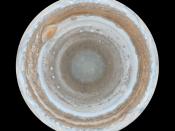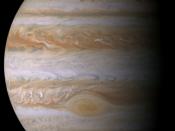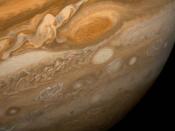JUPITER Jupiter the fifth planet from the sun and by far the largest, Jupiter is more than twice as massive as all the other planets combined (318 times Earth. What we see when we look at this planet as the tops of the clouds high in their atmospheres slightly above one atmosphere. Jupiter is about 90 percent hydrogen and 10 percent helium with traces of methane, water, ammonia and rock. To our knowledge the interior of Jupiter and the other gas planets is highly indirect and likely to remain so for some time. Jupiter may have a core of rocky material. Jupiter and other gas planets have high velocity winds, which are confirmed, in wide bands of latitude. The winds blow in opposite direction is adjacent. Jupiter and the other gas planets have high velocity winds, which are confined, in wide bands of latitude. The winds blow in opposite directions in adjacent bands.
The light colored bands are called zone and the dark ones belts.
The vivid colors seen in Jupiter's clouds are probably the result of subtle chemical reactions of the trace elements in Jupiter's atmosphere, perhaps involving sulfur whose compounds take on a wide variety of colors. The colors correlate with the cloud's altitude: blue lowest, followed by browns and whites, with red highest. Sometimes we see the lower layers through holes in the upper ones. The Great Red Spot has been seen by Earthly observers for more than 300 years. The GRS is an oval about 12,000 by 25,000 km, big enough to hold two Earths. Other smaller but similar spots have been known for decades. Infrared observations and the direction of its rotation indicate that the GRS is a high-pressure region whose cloud tops is significantly higher and colder than the surrounding regions. Similar structures have...


